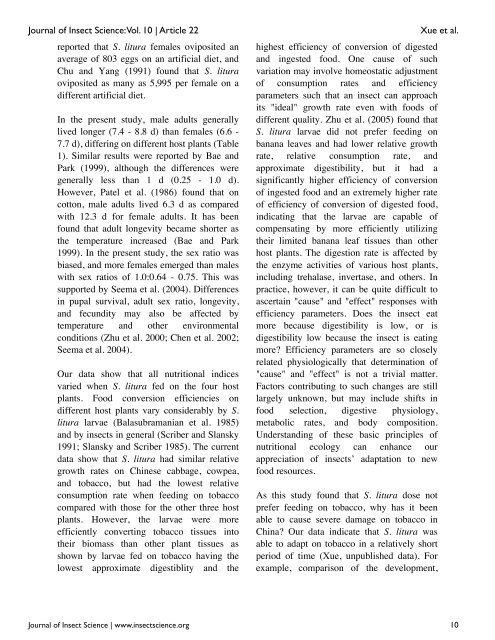Effects of four host plants on biology and food utilization - Journal of ...
Effects of four host plants on biology and food utilization - Journal of ...
Effects of four host plants on biology and food utilization - Journal of ...
You also want an ePaper? Increase the reach of your titles
YUMPU automatically turns print PDFs into web optimized ePapers that Google loves.
<strong>Journal</strong> <str<strong>on</strong>g>of</str<strong>on</strong>g> Insect Science: Vol. 10 | Article 22<br />
reported that S. litura females oviposited an<br />
average <str<strong>on</strong>g>of</str<strong>on</strong>g> 803 eggs <strong>on</strong> an artificial diet, <strong>and</strong><br />
Chu <strong>and</strong> Yang (1991) found that S. litura<br />
oviposited as many as 5,995 per female <strong>on</strong> a<br />
different artificial diet.<br />
In the present study, male adults generally<br />
lived l<strong>on</strong>ger (7.4 - 8.8 d) than females (6.6 -<br />
7.7 d), differing <strong>on</strong> different <str<strong>on</strong>g>host</str<strong>on</strong>g> <str<strong>on</strong>g>plants</str<strong>on</strong>g> (Table<br />
1). Similar results were reported by Bae <strong>and</strong><br />
Park (1999), although the differences were<br />
generally less than 1 d (0.25 - 1.0 d).<br />
However, Patel et al. (1986) found that <strong>on</strong><br />
cott<strong>on</strong>, male adults lived 6.3 d as compared<br />
with 12.3 d for female adults. It has been<br />
found that adult l<strong>on</strong>gevity became shorter as<br />
the temperature increased (Bae <strong>and</strong> Park<br />
1999). In the present study, the sex ratio was<br />
biased, <strong>and</strong> more females emerged than males<br />
with sex ratios <str<strong>on</strong>g>of</str<strong>on</strong>g> 1.0:0.64 - 0.75. This was<br />
supported by Seema et al. (2004). Differences<br />
in pupal survival, adult sex ratio, l<strong>on</strong>gevity,<br />
<strong>and</strong> fecundity may also be affected by<br />
temperature <strong>and</strong> other envir<strong>on</strong>mental<br />
c<strong>on</strong>diti<strong>on</strong>s (Zhu et al. 2000; Chen et al. 2002;<br />
Seema et al. 2004).<br />
Our data show that all nutriti<strong>on</strong>al indices<br />
varied when S. litura fed <strong>on</strong> the <str<strong>on</strong>g>four</str<strong>on</strong>g> <str<strong>on</strong>g>host</str<strong>on</strong>g><br />
<str<strong>on</strong>g>plants</str<strong>on</strong>g>. Food c<strong>on</strong>versi<strong>on</strong> efficiencies <strong>on</strong><br />
different <str<strong>on</strong>g>host</str<strong>on</strong>g> <str<strong>on</strong>g>plants</str<strong>on</strong>g> vary c<strong>on</strong>siderably by S.<br />
litura larvae (Balasubramanian et al. 1985)<br />
<strong>and</strong> by insects in general (Scriber <strong>and</strong> Slansky<br />
1991; Slansky <strong>and</strong> Scriber 1985). The current<br />
data show that S. litura had similar relative<br />
growth rates <strong>on</strong> Chinese cabbage, cowpea,<br />
<strong>and</strong> tobacco, but had the lowest relative<br />
c<strong>on</strong>sumpti<strong>on</strong> rate when feeding <strong>on</strong> tobacco<br />
compared with those for the other three <str<strong>on</strong>g>host</str<strong>on</strong>g><br />
<str<strong>on</strong>g>plants</str<strong>on</strong>g>. However, the larvae were more<br />
efficiently c<strong>on</strong>verting tobacco tissues into<br />
their biomass than other plant tissues as<br />
shown by larvae fed <strong>on</strong> tobacco having the<br />
lowest approximate digestiblity <strong>and</strong> the<br />
highest efficiency <str<strong>on</strong>g>of</str<strong>on</strong>g> c<strong>on</strong>versi<strong>on</strong> <str<strong>on</strong>g>of</str<strong>on</strong>g> digested<br />
<strong>and</strong> ingested <strong>food</strong>. One cause <str<strong>on</strong>g>of</str<strong>on</strong>g> such<br />
variati<strong>on</strong> may involve homeostatic adjustment<br />
<str<strong>on</strong>g>of</str<strong>on</strong>g> c<strong>on</strong>sumpti<strong>on</strong> rates <strong>and</strong> efficiency<br />
parameters such that an insect can approach<br />
its "ideal" growth rate even with <strong>food</strong>s <str<strong>on</strong>g>of</str<strong>on</strong>g><br />
different quality. Zhu et al. (2005) found that<br />
S. litura larvae did not prefer feeding <strong>on</strong><br />
banana leaves <strong>and</strong> had lower relative growth<br />
rate, relative c<strong>on</strong>sumpti<strong>on</strong> rate, <strong>and</strong><br />
approximate digestibility, but it had a<br />
significantly higher efficiency <str<strong>on</strong>g>of</str<strong>on</strong>g> c<strong>on</strong>versi<strong>on</strong><br />
<str<strong>on</strong>g>of</str<strong>on</strong>g> ingested <strong>food</strong> <strong>and</strong> an extremely higher rate<br />
<str<strong>on</strong>g>of</str<strong>on</strong>g> efficiency <str<strong>on</strong>g>of</str<strong>on</strong>g> c<strong>on</strong>versi<strong>on</strong> <str<strong>on</strong>g>of</str<strong>on</strong>g> digested <strong>food</strong>,<br />
indicating that the larvae are capable <str<strong>on</strong>g>of</str<strong>on</strong>g><br />
compensating by more efficiently utilizing<br />
their limited banana leaf tissues than other<br />
<str<strong>on</strong>g>host</str<strong>on</strong>g> <str<strong>on</strong>g>plants</str<strong>on</strong>g>. The digesti<strong>on</strong> rate is affected by<br />
the enzyme activities <str<strong>on</strong>g>of</str<strong>on</strong>g> various <str<strong>on</strong>g>host</str<strong>on</strong>g> <str<strong>on</strong>g>plants</str<strong>on</strong>g>,<br />
including trehalase, invertase, <strong>and</strong> others. In<br />
practice, however, it can be quite difficult to<br />
ascertain "cause" <strong>and</strong> "effect" resp<strong>on</strong>ses with<br />
efficiency parameters. Does the insect eat<br />
more because digestibility is low, or is<br />
digestibility low because the insect is eating<br />
more? Efficiency parameters are so closely<br />
related physiologically that determinati<strong>on</strong> <str<strong>on</strong>g>of</str<strong>on</strong>g><br />
"cause" <strong>and</strong> "effect" is not a trivial matter.<br />
Factors c<strong>on</strong>tributing to such changes are still<br />
largely unknown, but may include shifts in<br />
<strong>food</strong> selecti<strong>on</strong>, digestive physiology,<br />
metabolic rates, <strong>and</strong> body compositi<strong>on</strong>.<br />
Underst<strong>and</strong>ing <str<strong>on</strong>g>of</str<strong>on</strong>g> these basic principles <str<strong>on</strong>g>of</str<strong>on</strong>g><br />
nutriti<strong>on</strong>al ecology can enhance our<br />
appreciati<strong>on</strong> <str<strong>on</strong>g>of</str<strong>on</strong>g> insects’ adaptati<strong>on</strong> to new<br />
<strong>food</strong> resources.<br />
As this study found that S. litura dose not<br />
prefer feeding <strong>on</strong> tobacco, why has it been<br />
able to cause severe damage <strong>on</strong> tobacco in<br />
China? Our data indicate that S. litura was<br />
able to adapt <strong>on</strong> tobacco in a relatively short<br />
period <str<strong>on</strong>g>of</str<strong>on</strong>g> time (Xue, unpublished data). For<br />
example, comparis<strong>on</strong> <str<strong>on</strong>g>of</str<strong>on</strong>g> the development,<br />
Xue et al.<br />
<strong>Journal</strong> <str<strong>on</strong>g>of</str<strong>on</strong>g> Insect Science | www.insectscience.org 10

















